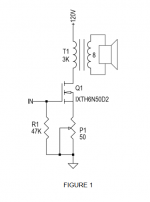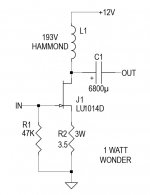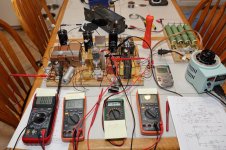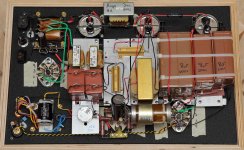Attachments
This guy puts it on a breadboard. I have not watched to the end...but really the amplifier sounds really nice even over my laptop speakers. Subjectively clear and wide open. Ok let me get my headphones. Ok clear, good power sharp response. I could listen to this one even on youtube.
Amp Camp Nelson Pass amplifier breadboard test - YouTube
Looks really straightforward on the breadboard. I could do this.
Amp Camp Nelson Pass amplifier breadboard test - YouTube
Looks really straightforward on the breadboard. I could do this.
Last edited:
I use Wago snap lock connectors to build prototype crossovers. I don’t see why it cannot be used for power amps.
WAGO 221 LEVER-NUTS 36pc Compact Splicing Wire Connector Assortment | eBay
They are quite secure and UL rated for 600v and 24ga to 12ga wire and 20A amps of current.
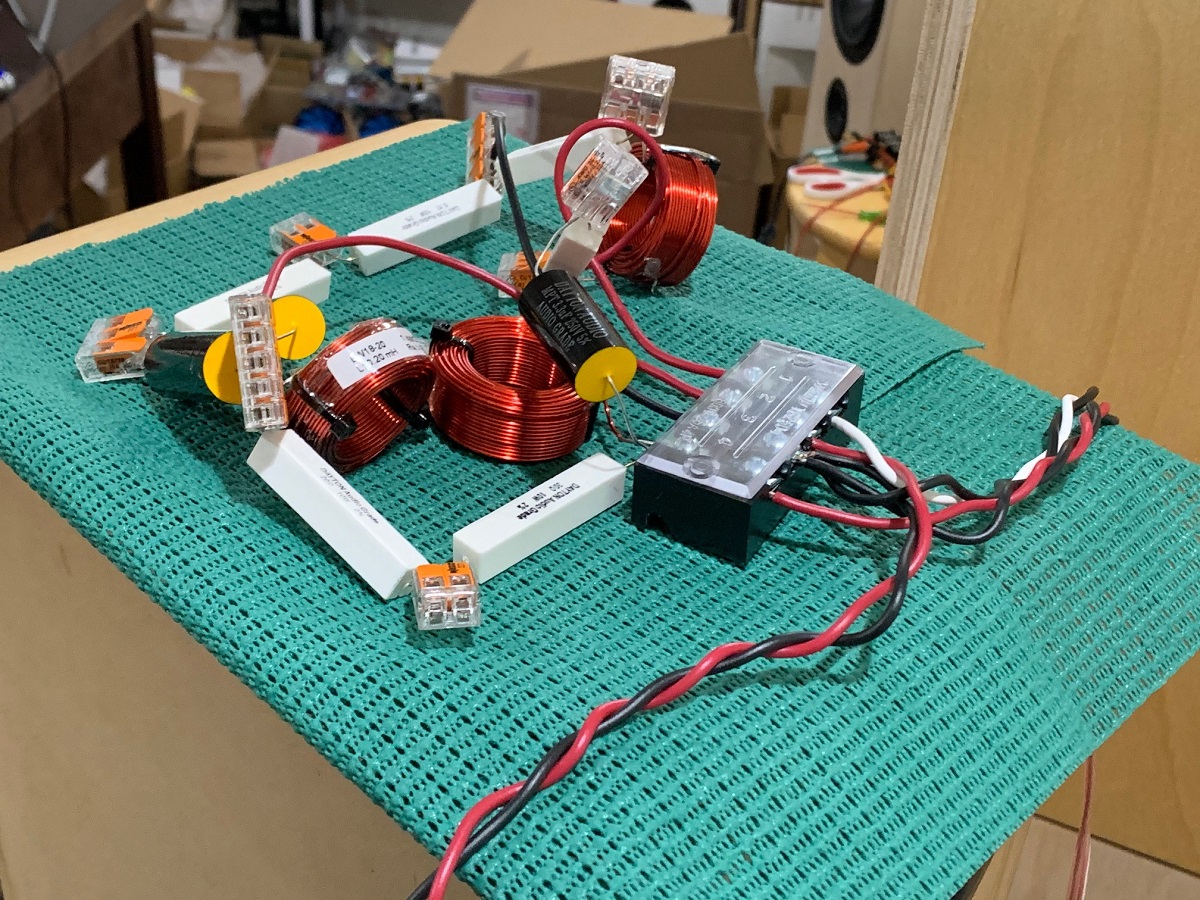
You have to watch out for wires touching each other and shorting out. So use insulated wires or add sleeves wherever bare wire is showing.
WAGO 221 LEVER-NUTS 36pc Compact Splicing Wire Connector Assortment | eBay
They are quite secure and UL rated for 600v and 24ga to 12ga wire and 20A amps of current.
You have to watch out for wires touching each other and shorting out. So use insulated wires or add sleeves wherever bare wire is showing.
Last edited:
And this with solder but no PCB.
Patrick
.
That thing is a work of art, Patrick if I may say so myself. Thanks for the pictures. The banana plug guitar amp is a great concept but really a case can be made for a better enclosure.
And as for Global Warming, which could be countered with pure Kool-Aid as someone suggested, pure, not laced as you see, well if I am getting 1 Watt output I will be putting in 8 Watts to listen to all the music I want. Where is the warming in that?
Of course one of these picture here had 3 x 100W power resistors in the background, but you could heat your room in the winter.
I have a suggestion:
from now on let "Class A" be pronounced as "Classy".
I am not seeking that name for my basic efforts but you get the idea.
from now on let "Class A" be pronounced as "Classy".
I am not seeking that name for my basic efforts but you get the idea.
Last edited:
For the OP ... In order for you to be taken seriously, would you explain what you want to be modular, and what you want to put together "solderless" in terms of individual components.
If one is to use a PCB-based / vero-board-based project, someone will need to do some soldering. If you plan to do everything just hanging in free air, then I don't know that too many people would recommend that for a number of reasons, both performance and safety rated.
Perhaps consider that you can buy pre-fabbed PSUs and amplifier modules. Your role as an assembler would simply be to connect the AC mains or DC supply, the PSU to the amplifier modules, and the I/O. All of this can conceivably and practically be done with no soldering done by you. Let someone else deal with the toxic fumes and the guilt of the global warming. 😀
Yes, sure - there could be a completely solderless solution, but do you really want one?
An option to get you started with Pass "kits" for yourself may be to look in the swap meet for folks selling off their pre-assembled "modules" or full amps.
Once you have your PSU etc. you could perhaps take the leap yourself to do a tiny bit of soldering or have a friend set you up to be able to remove and replace all of the amp boards completely without solder.
Just a thought. Hope you're not trolling us... b/c anyone that would like to contribute to their own build should be able to do so. I understand that "just learn" is not feasible for some. However, I think the likelihood of seeing a solderless "kit" for distribution is improbable at best.
Hope you find some fun.
If one is to use a PCB-based / vero-board-based project, someone will need to do some soldering. If you plan to do everything just hanging in free air, then I don't know that too many people would recommend that for a number of reasons, both performance and safety rated.
Perhaps consider that you can buy pre-fabbed PSUs and amplifier modules. Your role as an assembler would simply be to connect the AC mains or DC supply, the PSU to the amplifier modules, and the I/O. All of this can conceivably and practically be done with no soldering done by you. Let someone else deal with the toxic fumes and the guilt of the global warming. 😀
Yes, sure - there could be a completely solderless solution, but do you really want one?
An option to get you started with Pass "kits" for yourself may be to look in the swap meet for folks selling off their pre-assembled "modules" or full amps.
Once you have your PSU etc. you could perhaps take the leap yourself to do a tiny bit of soldering or have a friend set you up to be able to remove and replace all of the amp boards completely without solder.
Just a thought. Hope you're not trolling us... b/c anyone that would like to contribute to their own build should be able to do so. I understand that "just learn" is not feasible for some. However, I think the likelihood of seeing a solderless "kit" for distribution is improbable at best.
Hope you find some fun.
Member
Joined 2009
Paid Member
wire wrap if you can still get it (old hat) or screw down connectors and connector blocks are all good for building amps without solder (none of it any better for the environment).
I used to do wire wrap exclusively for quick digital logic circuits. Never thought about using it for analog projects. I still have the wires and the tool. The components though still need to be soldered to wire wrap pins which are inserted into a plain drilled PCB. The pins are square sharp edged to bite into the wrap wires for good contact. Round wire leads as on typical parts are no good for wrapping. Typically it’s old school DIP package that plugs into special wire wrap sockets.
Yes, they are still made. The leads are 0.025" square for wire wrap.
https://www.mouser.com/ProductDetail/Harwin/D0816-42?qs=ecHgFjcWJS%2Brp0Xb4F2tcA==
https://www.mouser.com/ProductDetail/Harwin/D0816-42?qs=ecHgFjcWJS%2Brp0Xb4F2tcA==
I built many wire-wrap projects as an electrical engineering student, and later for rapid prototyping of new products. Good wire wrapping technique will result in a fairly durable and robust circuit that may last for years. The Kynar insulated wire is typically 28 or 30 gauge, and the pressure of wrapping the wire onto square posts creates cold welds.
Developing good technique is something that should also be done for soldering components onto a PCB or even just to each other for point-to-point projects. Good soldering should be considered the foundation for DIY audio projects.
Developing good technique is something that should also be done for soldering components onto a PCB or even just to each other for point-to-point projects. Good soldering should be considered the foundation for DIY audio projects.
I never liked servicing stuff that had factory wire wrapping.
Hated it.
Thank god they don't do that crap any more.
Hated it.
Thank god they don't do that crap any more.
Classdaudio.com kits maybe? I think they don't require soldering.
But they're not class a as you want. But they are class d, which is perhaps better for the environment, as you want.
Everything is about trade-offs.
But they're not class a as you want. But they are class d, which is perhaps better for the environment, as you want.
Everything is about trade-offs.
And this with solder but no PCB.
Patrick
.
That's beautiful! Shame to hide it away in an enclosure.
It was used a lot in telephone exchanges, connecting the many relays. They work for 50 years or more. A wire wrap connection has the same or better connection quality than a solder connection. The special wire is tightly wrapped around a square pin (from e.g. the relay) with sharp edges. Every turn of the wire is parallel with the previous turn, reducing the connection resistance. Most likely also better against vibrations.I never liked servicing stuff that had factory wire wrapping.
Hated it.
Thank god they don't do that crap any more.
Wire wrap is probably better than solder which can have cold joints and adds an extra metal as the solder, whereas wire wrap is 4 cold-welded self-metal connections per wrap x circa 5-7 turns for 20 to 35 contact points per connection. They are also removable without heat using a wire de-wrapping tool. I liked working with them as they are secure and very fast to implement, but they can be tricky to track which goes where.
Pass DIY Addict
Joined 2000
Paid Member
Seems that I'm late again to the conversation, but thought others might like to order a T-shirt...
I used Wago connectors to prototype a tube amp build. While the terminations were relatively secure, it was a rats nest of wires and seemed a bit dangerous with 400v wires sticking up in the air. Then I rebuilt it a bit more cleanly.
I used Wago connectors to prototype a tube amp build. While the terminations were relatively secure, it was a rats nest of wires and seemed a bit dangerous with 400v wires sticking up in the air. Then I rebuilt it a bit more cleanly.
Attachments
Lovely P2P build there, Eric. 
You are a brave man to use Wago with 400v. (They are rated 1000v for signal wires).

You are a brave man to use Wago with 400v. (They are rated 1000v for signal wires).
+11111111111111111111111111Learning to solder is trivial, no good reason not to.
- Home
- Amplifiers
- Pass Labs
- Totally solder-less amplifier kits?
